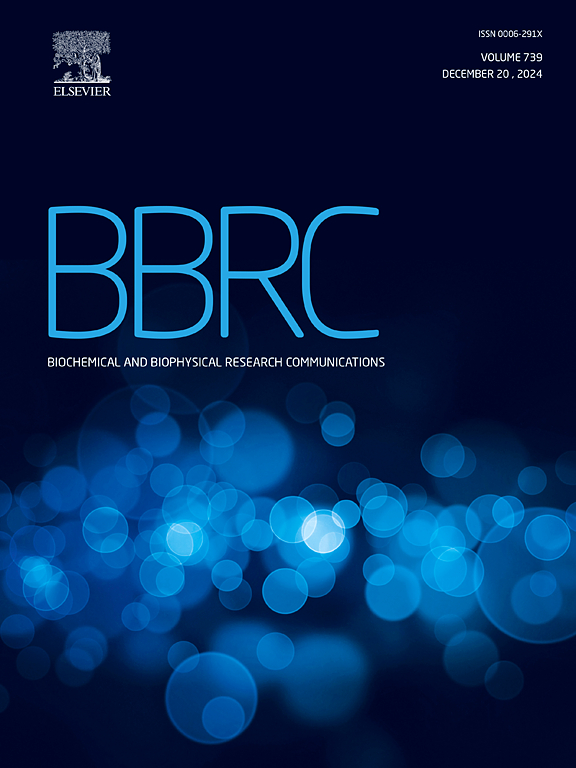Isoquercitrin improves diabetes nephropathy by inhibiting the sodium-glucose co-transporter-2 pathway
IF 2.5
3区 生物学
Q3 BIOCHEMISTRY & MOLECULAR BIOLOGY
Biochemical and biophysical research communications
Pub Date : 2025-01-01
DOI:10.1016/j.bbrc.2024.151142
引用次数: 0
Abstract
Diabetic nephropathy (DN) is one of the most severe kidney complications and the primary contributor to end-stage renal disease on a global scale. It exacerbates the morbidity, mortality, and financial burden for individuals with diabetes. Isoquercitrin, a natural compound found in various plants, has demonstrated potential as an antidiabetic agent. However, it remains uncertain whether isoquercitrin exerts a protective effect on DN. Therefore, the objective of this study was to explore whether isoquercitrin confers a protective effect on DN and its potential mechanism. In vivo, a mouse model of DN induced by streptozotocin was established in the study. The hypoglycemic effect of isoquercitrin was assessed by measuring fasting blood glucose levels, insulin tolerance tests, and glucose tolerance test in animals. Urinary albumin creatinine ratio, serum lipid levels, and pathological changes in renal tissues were measured to evaluate the protective effect of isoquercitrin against DN. The expression of Sodium glucose co-transporter-2(SGLT2) was analyzed using real-time quantitative PCR and immunohistochemistry. The studies suggest that isoquercitrin significantly reduces fasting blood glucose levels, enhances the body's capacity to regulate blood glucose and insulin resistance, and facilitates renal pathology and renal function. Simultaneously, it can lower blood lipids (total cholesterol and triglyceride) and improve the risk factors of DN. Meanwhile, isoquercitrin suppressed the expression of SGLT2 in renal tissues of DN mouse models. In vitro, real-time quantitative PCR and Western blot were used to detect the expression of SGLT2 in the human renal tubular epithelial (HK-2) cells. The effects of isoquercitrin on the survival rate and glucose uptake capacity of HK-2 cells were determined by Cell-Counting-Kit-8 and glucose uptake methods. The results demonstrate that isoquercitrin suppressed the up-regulation of SGLT2 mRNA and protein in high-glucose-induced HK-2 cells. Additionally, isoquercitrin inhibited glucose uptake in HK-2 cells and mitigated high-sugar-induced damage. Thus, this study has concluded that isoquercitrin exhibits hypoglycemic and renal protective effects by inhibiting the SGLT2 pathway, indicating its potential as a promising anti-DN drug deserving further clinical investigation.
异槲皮素通过抑制钠-葡萄糖共转运体-2途径改善糖尿病肾病。
糖尿病肾病(DN)是全球范围内最严重的肾脏并发症之一,也是导致终末期肾脏疾病的主要原因。它加剧了糖尿病患者的发病率、死亡率和经济负担。异槲皮苷是一种存在于多种植物中的天然化合物,具有潜在的抗糖尿病作用。然而,异槲皮素是否对DN有保护作用尚不确定。因此,本研究的目的是探讨异槲皮苷是否对DN具有保护作用及其可能的机制。在体内,本研究建立链脲佐菌素诱导的DN小鼠模型。通过测定动物空腹血糖水平、胰岛素耐量试验和葡萄糖耐量试验评估异槲皮苷的降糖作用。测定尿白蛋白肌酐比、血脂水平和肾组织病理变化,评价异槲皮苷对DN的保护作用。采用实时定量PCR和免疫组织化学方法分析葡萄糖共转运蛋白-2(SGLT2)的表达。研究表明,异槲皮苷能显著降低空腹血糖水平,增强机体调节血糖和胰岛素抵抗的能力,促进肾脏病理和肾功能。同时还能降低血脂(总胆固醇和甘油三酯),改善DN的危险因素。同时,异槲皮素抑制DN小鼠肾组织中SGLT2的表达。体外应用实时定量PCR和Western blot检测SGLT2在人肾小管上皮细胞(HK-2)中的表达。采用cell - count - kit -8和葡萄糖摄取法检测异槲皮苷对HK-2细胞存活率和葡萄糖摄取能力的影响。结果表明,异槲皮苷抑制高糖诱导的HK-2细胞中SGLT2 mRNA和蛋白的上调。此外,异槲皮苷抑制HK-2细胞的葡萄糖摄取,减轻高糖诱导的损伤。因此,本研究认为异槲皮苷通过抑制SGLT2通路具有降血糖和肾脏保护作用,提示其作为抗dn药物的潜力值得进一步临床研究。
本文章由计算机程序翻译,如有差异,请以英文原文为准。
求助全文
约1分钟内获得全文
求助全文
来源期刊
CiteScore
6.10
自引率
0.00%
发文量
1400
审稿时长
14 days
期刊介绍:
Biochemical and Biophysical Research Communications is the premier international journal devoted to the very rapid dissemination of timely and significant experimental results in diverse fields of biological research. The development of the "Breakthroughs and Views" section brings the minireview format to the journal, and issues often contain collections of special interest manuscripts. BBRC is published weekly (52 issues/year).Research Areas now include: Biochemistry; biophysics; cell biology; developmental biology; immunology
; molecular biology; neurobiology; plant biology and proteomics

 求助内容:
求助内容: 应助结果提醒方式:
应助结果提醒方式:


